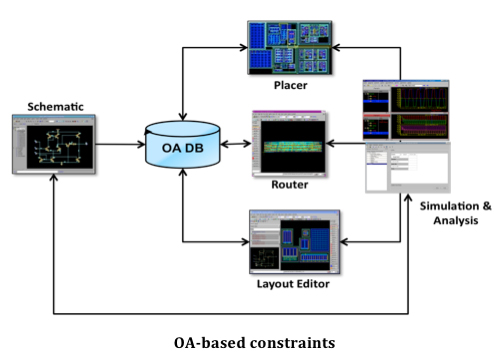 Over the years there has been a lot of standard creation in the IC design world to allow interoperability of tools from different vendors. One area of recent interest is interoperable constraints for custom IC design. Increasingly, analog design layout is becoming more automated. Advanced process nodes require trial layouts to be created even during the circuit design stage, to bring back detailed information for the iterative simulation loops. In particular, variation in sub 30nm nodes is impacted by layout dependent effects (LDEs), essentially values depend on proximity effects of what else is around, meaning that circuit design and layout design are much more closely intertwined than they were in the past. Otherwise correlation between pre- and post-layout is not assured.
Over the years there has been a lot of standard creation in the IC design world to allow interoperability of tools from different vendors. One area of recent interest is interoperable constraints for custom IC design. Increasingly, analog design layout is becoming more automated. Advanced process nodes require trial layouts to be created even during the circuit design stage, to bring back detailed information for the iterative simulation loops. In particular, variation in sub 30nm nodes is impacted by layout dependent effects (LDEs), essentially values depend on proximity effects of what else is around, meaning that circuit design and layout design are much more closely intertwined than they were in the past. Otherwise correlation between pre- and post-layout is not assured.
To make the prototype layout process work smoothly, design constraints must be communicated to the layout automation, but there is currently no common open standard for defining these design constraints. As a result, users are forced to enter these constraints multiple times, once for each tool. Worse, subtle differences in the semantics can cause problems. To remedy this, the IPL Alliance, whose original charter was centered around open PDKs, has embarked on an initiative to create a single unified set of constraint definitions, covering both the syntax and the semantics. The goal, obviously, is to allow the designer to enter the constraints once and use tools from multiple vendors to achieve their design goals: higher quality, higher productivity, reduced time to market. The IPL Constraints Standard is available to all IPL Alliance members and is expected to be made public sometime in mid-2012.
The history is that in 2010 the IPL alliance decided to try and get ahead of the creation of design constraint standards. Otherwise every vendor would create their own proprietary standards and it is a lot harder to try and get alignment once such standards have achieved some adoption since there genuinely are costs of change and opportunity for political fighting among the most widely adopted standards.
The group’s goals were that the standard should be:
- Portable and interoperable
- Support existing and future tool sets
- Be extensible
- Take into account multiple ways that the constraints might be created: by hand, through GUIs, scripted, automated
- Take into account the entire design flow where many steps are co-dependent.
A decision was made to support text-based and openAccess-based constraints, and tools should be able to translate between the two representations if necessary without semantic problems.
 At DAC in 2011 the IPL Design Constraint Working Group announced the IPL Constraints 1.0 standard, which defines the syntax and schema for open, interoperable design constraints and included a proof-of-concept set of constraints. Work is going on to expand the standard to include a broader representation of actual constraints and to validate the interoperable use model.
At DAC in 2011 the IPL Design Constraint Working Group announced the IPL Constraints 1.0 standard, which defines the syntax and schema for open, interoperable design constraints and included a proof-of-concept set of constraints. Work is going on to expand the standard to include a broader representation of actual constraints and to validate the interoperable use model.
The presentation from the 2011 DAC luncheon is here.
Note: You must be logged in to read/write comments








Quantum Computing Technologies and Challenges